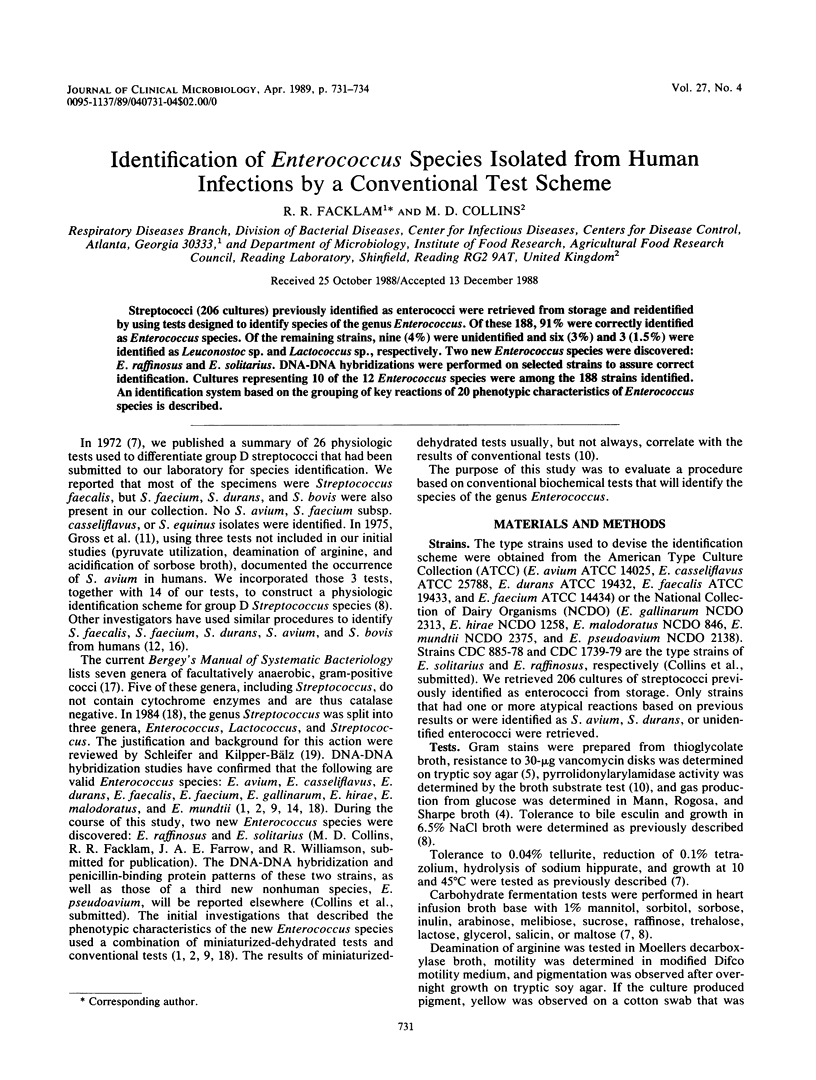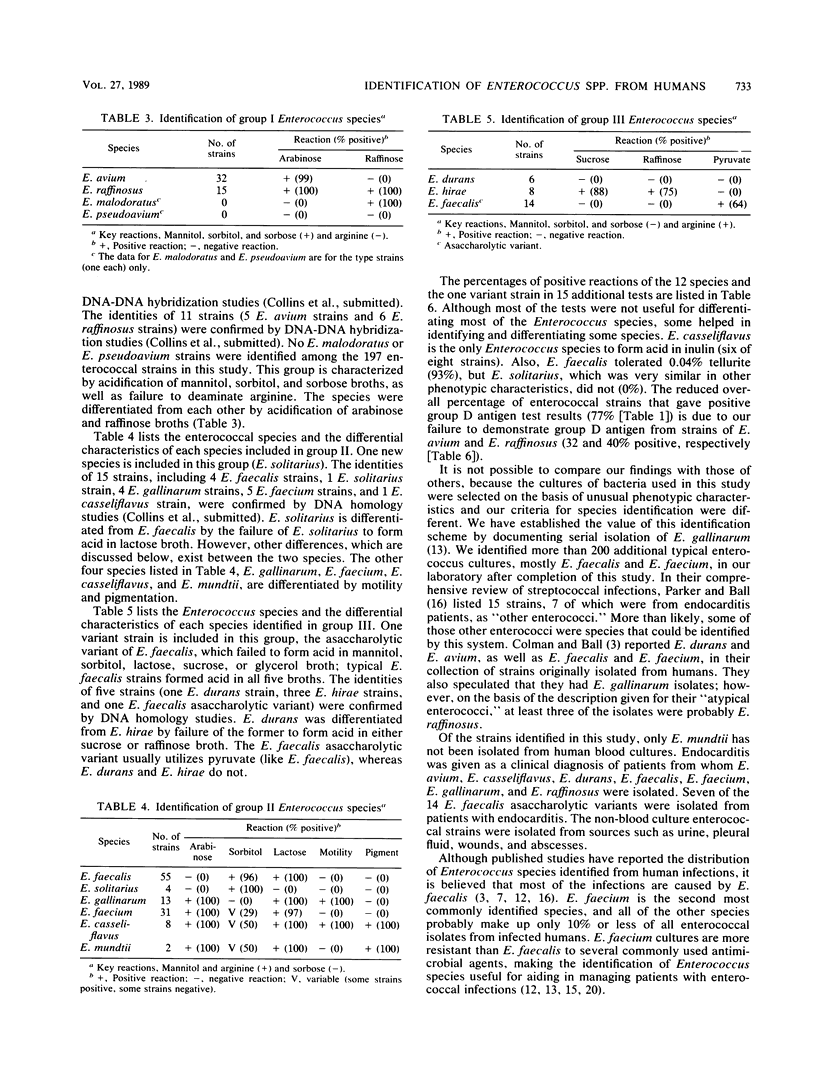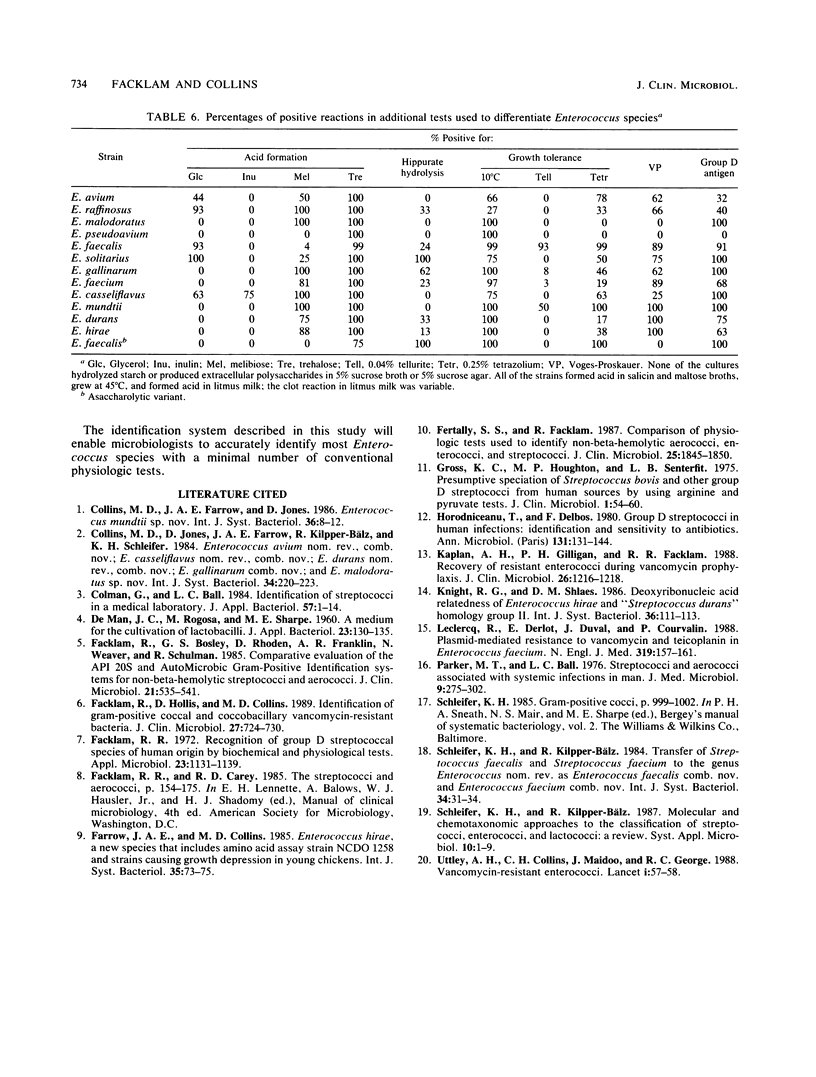Abstract
Streptococci (206 cultures) previously identified as enterococci were retrieved from storage and reidentified by using tests designed to identify species of the genus Enterococcus. Of these 188, 91% were correctly identified as Enterococcus species. Of the remaining strains, nine (4%) were unidentified and six (3%) and 3 (1.5%) were identified as Leuconostoc sp. and Lactococcus sp., respectively. Two new Enterococcus species were discovered: E. raffinosus and E. solitarius. DNA-DNA hybridizations were performed on selected strains to assure correct identification. Cultures representing 10 of the 12 Enterococcus species were among the 188 strains identified. An identification system based on the grouping of key reactions of 20 phenotypic characteristics of Enterococcus species is described.
Full text
PDF



Selected References
These references are in PubMed. This may not be the complete list of references from this article.
- Colman G., Ball L. C. Identification of streptococci in a medical laboratory. J Appl Bacteriol. 1984 Aug;57(1):1–14. doi: 10.1111/j.1365-2672.1984.tb02351.x. [DOI] [PubMed] [Google Scholar]
- Facklam R. R. Recognition of group D streptococcal species of human origin by biochemical and physiological tests. Appl Microbiol. 1972 Jun;23(6):1131–1139. doi: 10.1128/am.23.6.1131-1139.1972. [DOI] [PMC free article] [PubMed] [Google Scholar]
- Facklam R., Bosley G. S., Rhoden D., Franklin A. R., Weaver N., Schulman R. Comparative evaluation of the API 20S and AutoMicrobic gram-positive identification systems for non-beta-hemolytic streptococci and aerococci. J Clin Microbiol. 1985 Apr;21(4):535–541. doi: 10.1128/jcm.21.4.535-541.1985. [DOI] [PMC free article] [PubMed] [Google Scholar]
- Facklam R., Hollis D., Collins M. D. Identification of gram-positive coccal and coccobacillary vancomycin-resistant bacteria. J Clin Microbiol. 1989 Apr;27(4):724–730. doi: 10.1128/jcm.27.4.724-730.1989. [DOI] [PMC free article] [PubMed] [Google Scholar]
- Fertally S. S., Facklam R. Comparison of physiologic tests used to identify non-beta-hemolytic aerococci, enterococci, and streptococci. J Clin Microbiol. 1987 Oct;25(10):1845–1850. doi: 10.1128/jcm.25.10.1845-1850.1987. [DOI] [PMC free article] [PubMed] [Google Scholar]
- Gross K. C., Houghton M. P., Senterfit L. B. Presumptive speciation of Streptococcus bovis and other group D streptococci from human sources by using arginine and pyruvate tests. J Clin Microbiol. 1975 Jan;1(1):54–60. doi: 10.1128/jcm.1.1.54-60.1975. [DOI] [PMC free article] [PubMed] [Google Scholar]
- Horodniceanu T., Delbos F. Les streptocoques du groupe D dans les infections humaines: identification et sensibilité aux antibiotiques. Ann Microbiol (Paris) 1980 Sep-Oct;131B(2):131–144. [PubMed] [Google Scholar]
- Kaplan A. H., Gilligan P. H., Facklam R. R. Recovery of resistant enterococci during vancomycin prophylaxis. J Clin Microbiol. 1988 Jun;26(6):1216–1218. doi: 10.1128/jcm.26.6.1216-1218.1988. [DOI] [PMC free article] [PubMed] [Google Scholar]
- Leclercq R., Derlot E., Duval J., Courvalin P. Plasmid-mediated resistance to vancomycin and teicoplanin in Enterococcus faecium. N Engl J Med. 1988 Jul 21;319(3):157–161. doi: 10.1056/NEJM198807213190307. [DOI] [PubMed] [Google Scholar]
- Parker M. T., Ball L. C. Streptococci and aerococci associated with systemic infection in man. J Med Microbiol. 1976 Aug;9(3):275–302. doi: 10.1099/00222615-9-3-275. [DOI] [PubMed] [Google Scholar]
- Uttley A. H., Collins C. H., Naidoo J., George R. C. Vancomycin-resistant enterococci. Lancet. 1988 Jan 2;1(8575-6):57–58. doi: 10.1016/s0140-6736(88)91037-9. [DOI] [PubMed] [Google Scholar]


